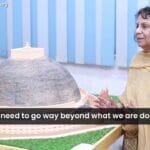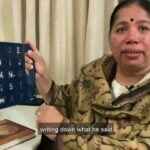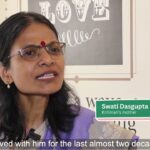Amvalika Senapati – Shishu Sarothi
In this film, Amvalika Senapati, Deputy Director, Shishu Sarothi, brings empathy and urgency to the conversation around disability rights. With her years of experience in advocacy, Amvalika speaks of the everyday barriers people with disabilities face, not just in infrastructure or systems, but in mindsets. At Shishu Sarothi, through workshops, community engagement, and policy-level advocacy, the team is actively dismantling stigma, this film is a window into that effort and call for advocacy.
Awareness isn’t optional, it’s essential. Without it, rights remain out of reach, and inclusion stays stuck on paper.
In this film, Amvalika Senapati, Senior Advocacy Program Associate at Shishu Sarothi, brings clarity, urgency, and heart to the conversation around disability rights and awareness. What she stands for is not just a vision, it’s a reality at Shishu Sarothi, where real change is being made through advocacy and action.
*
So advocacy and awareness in the disability rights space is very crucial, I think, because if we look at advocacy, this is the key medium through which we can amplify the voices of people with disabilities, we can promote inclusion of people with disabilities.
Now, I think um I’ll be also overusing the word inclusion when I’m talking because it’s become so much of a cliche word but truly understanding what is inclusion is really something which has to be done at so many levels, because it’s not something which just, which has to be done only in the letter, it has to be there very much in the spirit.
When we’re talking about inclusion of people with disabilities, it cannot be something which we do just because, you know, it’s a tick mark on the list, you know, ‘we have done, done it’.
It has to be meaningful inclusion, whether it’s inclusion in the school of children or whether it’s, you know, providing an accessible building for people with disabilities.
So when we talk about this in, in our work, which is mainly surrounding advocacy and awareness, these are two very important pillars to ensure that people have access to their rights.
Because on one hand, people with disabilities very often don’t know, are not aware of their rights, and they are like, ‘okay, I am helpless, I have to wait for the government schemes to be doled out, you know, I’m dependent on my family, I can’t do anything on my own’.
So it’s very important to break this mindset barrier that they have, that they have a right to a quality inclusive education in schools, they have a right to access all forms of facilities and services that you and I access, and to good jobs.
But to do that, they do not have the services, they do not have access to those.
So they need to be aware of their rights, for one.
And secondly, duty bearers, the society at large also needs to be aware that, what needs to be done, what are the roles and responsibilities we as the government, we as the state have, to ensure that people with disabilities have access to all of their rights.
So it’s a, it’s a two-way thing, it’s like, you know, two sides of the coin, one, one is the rights and the other is the duty.
So it’s very important that we create awareness with all groups of stakeholders, you know, right from the grassroot workers, like Anganwadis and ASHAs, to the highest level of office bearers, whether it be the judiciary, whether it be executive officers, whether it be the civil servants, everybody needs to be aware of what needs to be done in the disability space.
Our mindset is just that we have an understanding that disability comes within the scope of Social Justice and Empowerment or Social Welfare, and some other states call it by some other names like Social Welfare and Education Departments, in some states it’s called like that as well.
So our idea is that disability is the responsibility of this department, but it’s not.
If I’m looking at accessible roads and transportation, I have to probably look at PWD roads, PWD buildings, if I’m looking at quality inclusive education, it’s an Education Department which has a role to play, so, so on.
If I’m looking at, say for example, Assam, it’s such a flood-prone state, every year we are, you know, torn apart by floods in so many what you call districts across the state.
So what happens for this?
It is the Revenue and Disaster Management department who is responsible for ensuring that your evacuation systems are inclusive, and then again when we are looking at the idea of accessibility, whether it is in a relief area or in a disaster area, or even accessibility for a simple plain old building, say for example, the concept that we have as a common man is that, okay, this building has a ramp, it’s accessible, but accessibility goes so far beyond the ramp.
So it’s very important that we create awareness around these issues, and accessibility is not only for somebody with physical limitations, accessibility could be for somebody with, you know, visual impairment, with hearing impairment, somebody with neurodivergence, and somebody also, say for example, somebody with autism would require accessibility, somebody with intellectual disability would require accessibility.
So what is the kind of accessibility they require to make spaces inclusive for them every way?
So advocacy is something which is applicable in each and every sphere of your life.
If you are talking about sports, advocacy will come, how do you make the sporting avenues accessible, how do you make the whole process accessible for para-athletes to be a part of it, or even for them to be part of the regular games?
Talk about entertainment.
So we need to do big time advocacy, because we think advocacy is about, sorry, inclusion is about, you know, a job is given or we provide education and that’s it.
No, our life is a whole rounded life.
Besides education and health and education, we need entertainment, we need a full rounded life, and people with disabilities also need that.
So it is also about how we are leaving them out of the space of entertainment.
Can they access a movie hall in your hometown?
That’s a question.
We need to all reflect, why don’t I see a person with disability in the marketplace?
Why don’t I see randomly a person with a disability in the, in the bank, or, you know, in the post office, or in a shopping mall?
It’s not because they don’t want to come out of their houses.
They do.
But they are very much the invisible population because they cannot come out, because of all of the barriers, including the biggest barrier, the, you know, the discriminations that they face at the attitudinal level.
So all these are things that we can only break down with advocacy and awareness.
And these are, I think, the two most important things that all of us who are working in the disability space, whether we are working on disability and education, disability and employment, or on livelihood, or on sports, or on any other area, rehabilitation area, advocacy and awareness, I think, goes hand in hand at every part of it.
*
Could you share some of the recent work Shishu Sarothi has been involved in?
So from Shishu Sarothi, we recently did a awareness training.
It was a three-day orientation program that we did for the students of a college of architecture here at Guwahati.
Because as of today, though the push is, has been there, as of today, the architecture course doesn’t have a, what you call, module, or a chapter, or, you know, paper on making buildings accessible.
Now, as the future designers of buildings, they need to know how you will design a building which is accessible.
And most importantly, there’s a huge gap.
As an architect, when you get a degree, it is not rocket science, accessibility is not that.
So they can just look up the manual, which is there, the Harmonised Guideline, and they can very well do it.
But what is missing in that, when they just read the guideline clinically, is this that they miss out on why this is required.
So they may be like, “OK, this says 1:12 gradient, it’s okay, I have less space, I’ll make it 1:10”, but what was the principle behind making it 1:12?
That it’s a matter of dignity.
It is a matter of independent use of the ramp by a person with disability.
And most importantly, it’s also a matter of safety.
When you make a very steep ramp, which is 1:5, safety just goes out the window.
So it’s very important for us to understand the essence of why these specifications are there for accessibility.
So as an empaneled auditor, we have done these kind of things.
And our advocacy is very much towards ensuring all buildings are accessible.
A lot needs to be done, and recently, with the Supreme Court judgment about accessibility, it has been a very path-breaking landmark judgment and we are really excited that now meaningful change will happen.
This is something we are all looking at forward to.
So, and we do advocacy with, on other spaces as well, like I already mentioned, we are part of a platform called the Interagency Group in Assam, which is a group of organizations working only in disaster.
So we kind of partner with them just to give them inputs on how to make, you know, provisions that you work for during disasters, make them inclusive.
So this is a very major area of our work.
And also, the Right to Edu…, the Rights of Persons with Disabilities Act today is a very powerful tool in our hands.
Whenever we have done a case from Shishu Sarothi using the law, whether it was previous law of 1995 or the present law from 2016, we have always had favorable judgments for the court.
It means what?
It means that our law is a very strong document.
It is there on paper.
But in execution, we do see a lot of gap.
So the law is a powerful tool.
If you can just use that law to help, you know, take up your case when people’s rights are violated, I think it’s a wonderful tool.
But yes, we do understand that there are so many challenges, of people not having access to good legal advice, perhaps, or, you know, very often, people also do not keep the proper documentation.
That also becomes a challenge in doing the case.
So it’s very interesting that. more needs to happen in this space.
A lot has happened, I must say.
If I look back 10, 15 years, and I have been working in this space, in the disability sector for the last 15 years, and I still think there’s something new that I learn every day when I talk about accessibility or about some aspect of disability.
There’s so much to learn and so much to do.
And it’s truly about “nothing about us without us”.
Every day, I learn from a, a unique new challenge that a person with disability face.
Say, for example, I talked, I know accessibility is one of the core areas I work in, and recently, I got to know, I have worked in accessibility for the past over 12 years, only recently, I got to know from a student who told me that he’s a person with hearing impairment, he’s, he’s hard of hearing, about 70%, he told me that, “I don’t go to school during the summer months, during the monsoon months”
And I said, why?
I just couldn’t fathom it.
I couldn’t understand.
He said, “no, it’s difficult to attend classes”
I said, how so?
And he’s from a remote district in Assam.
And I really couldn’t fathom.
He said, “ma’am, I don’t understand what the teacher speaks”.
And I’m like, why? What’s the difference between summer and winter?
He said, “ma’am, I can’t understand anything in monsoons, because when the rain falls on the tin roof, it creates such a cacophony of sound, I can’t understand what the teacher is saying”
I said, this is something I could never have thought about in my life.
This is definitely not there, not there in the Harmonized Guideline.
So this, these are things, you know, new pearls of wisdom that we get to learn every day.
And there’s so much to learn from this, from each other, in this space.
accessibility, advocacy, Amvalika Senapati, awareness, community engagement, Disability Justice, disability rights, empowerment, equal rights, human rights, inclusion, inclusive education, inclusive society, lived experience, mindset shift, Policy Change, real stories, representation, Shishu Sarothi, Social Change
Dive Deeper: More on Disability
Learn about the most common inquiries surrounding disability, education, legislation, accessibility, employment and other sectors related to disability.


















